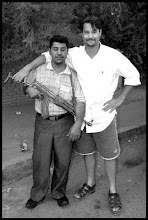They say, no good deed goes unpunished. I'm hoping that won't end up being the case to this particular story.
Back in March of 2007, ePluribus Media published the first article in a three-part series which I wrote, Iraq, Contingency Contracting and the Defense Base Act. In part, the article highlighted the situation of the von Ackermann family and the lack of insurance benefits they received after Kirk von Ackermann, a civilian contractor, disappeared in Iraq in 2003.
Von Ackermann's employer at the time, Ultra Services of Istanbul Turkey, did not carry Defense Base Act insurance, similar to workman's compensation for overseas contractors. The Defense Base Act pays benefits if a contractor is killed, injured or missing. Claims under the Defense Base Act are administered by the Department of Labor.
As a result of that series, an attorney retired from the Department of Labor contacted me with questions about the article and in particular, the plight of the von Ackermann family. I pointed him to the Missing in Iraq blog and as Megan has noted at her blog, he went on to eventually take on their case.
It is my understanding that he pursued benefits for the family under the War Hazards Compensation Act. The War Hazards Compensation Act is a component of the Defense Base Act but applies only to those killed, injured or missing due to the actions of hostile forces. The War Hazards Compensation Act reimburses by 100% all benefits. As the US Army CID had determined in 2006 that Kirk von Ackermann was abducted and killed by hostile forces, the claim falls clearly under the War Hazards Act.
In other words, even if Kirk von Ackermann's employer had secured Defense Base Act insurance as required, all benefits would have been reimbursed by the Federal Government any way, in effect rendering the middle man of an insurance company as moot.
While I don't know the details beyond what Megan von Ackermann has posted on her blog (see Yuliscious), just shortly before Christmas, a check arrived from the Department of Labor - over 6 years after Kirk von Ackermann disappeared in Iraq. The Department of Labor finally recognized her claim.
Without ePluribus Media, that little bit of righting a wrong might never have happened. I'd like to take a moment to thank here everyone who helped make the series possible.
Original credits for those who worked on the article, proofreading, editing, fact checking, etc at ePluribus Media are: rba, newton snookers, cho, intranets, steven reich, greyhawk, wanderindiana, XicanoPwr, standingup, roxy
Additional Reading
Yuliscious
By Megan von Ackermann, Missing in Iraq, December 24, 2009
Defense Base Act vs War Hazards Compensation Act - graphic
December 23, 2008
The Defense Base Act - insurance for contractors
April 6, 2007
Iraq, Contingency Contracting and the Defense Base Act - reprint
March 7, 2007




